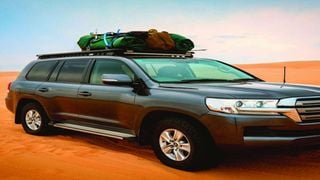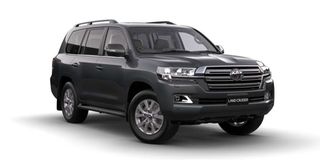
Toyota Landcruiser 200.
| Pool | Nation Media GroupNews
Premium
Ode to Landcruiser 200, iconic beast of the road
What you need to know:
- At 14 years, the 200’s production run was the longest of all top-tier Landcruisers’.
- Will there be a replacement? Probably. Some are already talking of a 300 series.
The Toyota Landcruiser; cruiser of the land, off-roader extraordinaire and at one point my favourite vehicle. Its history is as rich as it is varied; and today... today we mark a milestone in that history.
The 200 Series version of this nameplate, commonly and somewhat erroneously referred to as the "V8", has reached the end of its production run. The venerable Landcruiser is no more, probably, because as we speak, it is still unclear whether this is it for the Toyota flagship or if it is just a hiatus and we may be seeing a 300 Series in the near future.
I will not dabble in the past, telling what was and what went on because we have Wikipedia for that. What we'll do instead is talk about this particular model that is the swansong of the epitome of the definition of what a mud-plugging pose-mobile should be. Listen up.
The 200 Series was quite the car. Handsome, imposing and carrying design elements evolved from its predecessors (the 80 and 100 Series), when it landed it met a planet deeply in worship of the brand. Expectations were high, and delivery was prompt.
Rave reviews went everywhere, because this was a Landcruiser; what could possibly be wrong with it?
There was a lot that was wrong, actually. Weighing in at a peak of 2,700kg, the vehicle was extremely heavy, which is not a good thing.
Massive engines
The engines were massive, which created a fearsome thirst that even the twin-turbocharged-and-intercooled direct injection D4-D V8 diesel, the venerable 1VD-FTV, could not palliate.
Single-digit consumption figures were the norm. The petrol versions were far worse in this aspect; and there were three versions to select from.
There was the 4.0-litre 1GR-FE V6, which was popular and exclusive to the Middle East. That same engine served duty in the Hilux, the Surf and the Prado - less substantial vehicles than the granddaddy itself, and it proved in tests to be not enough engine for that vehicle.
It struggled to lug that mass around. Most of these versions can be found cresting the dunes in the Arabian deserts as fleet vehicles where business sense demands maximum image (Toyota Landcruiser) at minimum cost (limp-wristed V6).
Then there was a pair of V8s; the first being the 4.7-litre 2UZ-FE, carried over from the 100 Series, which was then replaced by the 4.6-litre 1UR-FE somewhere in the vehicle's production run. A lot of the "V8s" you see running around have the 2UZ block in them.
The vehicle was not just heavy, it was also massive. Yuuuge!, if the one-term former American president was to pitch in. I did a review of the car and I distinctly remember writing that parking and unparking this vehicle called for heavy commercial skill sets with the added bonus of the possibility of children dying in the path of a reversing Landcruiser. The best one-word description I can come up with is "unwieldy".
Tenderizing scene
So, the vehicle looked the part, and it attracted all types. It was initially bought by the daring and the committed, real money types, brand new, at about Sh15 million. The vehicle I tested back then was the exact same unit in use by the then Managing Director of Toyota Kenya, in 2011; an electric blue pre-facelift diesel unit in VX spec that we "stole" from the Toyota Kenya parking lot while the man was hard at work in his office, and did a quick run in it, put it on a dynamometer (238hp indicated, which was dead accurate according to the brochure), drove through muddy water then placed it back where we found it. It was surprisingly very poorly spaced. No screen, no CD, no USB; but it did have a radio cassette deck. A tape deck in a brand new car, in 2011. Wow!
The aforementioned asking price kept the sales nice and slow in the early days, but this is Kenya. The import scene happened where these vehicles could be had for half that price in exchange for a few thousand kilometers on the drivetrain.
Then the “tenderizing” scene happened; “tenderpreneurship”, a phenomenon that I don’t need to explain, because if you live in this country you know exactly what I mean. Big money meet cut-price Landcruiser. The vehicle started filling up the roads.

Toyota Landcruiser 200. Pool | Nation Media Group
There is a very interesting observation that I made during those years. The brand new version sold by Toyota Kenya, exclusively powered by the twin-turbo 1VD engine, kept going up in price.
However, the used ones kept going down in price, specifically the petrol powered versions, the 4.7 V8s. This was strange, given that Toyotas are known to hold their value and Landcruisers sometimes appreciate instead of depreciating. This was an extreme shift from the norm.
How extreme? Let’s start with the initial showroom price: 15 millions. The new vehicle’s price tag soared by a cool 50 per cent to the point the current (outgoing) face-lifted VDJ202 peddles for about 22 million bones. Yikes!
Government officials
The used ones on the other hand have dropped in price so drastically you can have an early 2UZ-powered example with a plate as recent as KCG for as little as Sh3.5 million; basically the same price as the old 100. Odd, huh?
There is an explanation behind this: The tenderpreneurs flocked to this vehicle because it made them look like senior government officials, especially in black (which is why a lot of these vehicles are black); these government officials being the initial customer base.
However, senior government officials have chauffeurs and allowances that enable them to sling such substantial machinery. Tenderpreneurs don’t have these perks: they have to drive themselves and any operational costs are almost always out of pocket.

Toyota Landcruiser 200. Pool | Nation Media Group
The “hustlers” very quickly discovered what I mean when I write “unwieldy”. The vehicle is genuinely difficult to drive, more so if you are graduating from a humble saloon and are unused to piloting three tonnes worth of V8-powered metal.
These same people also discovered, just as rapidly, what owning and operating a V8-powered vehicle entails. Fuel and servicing costs were stratospheric, the huge tyres were not cheap either and the large mass of the vehicle meant that it ate its brakes on the regular.
Disc replacements were a standard menu entry if you dined on the table of the 200 (one can upgrade the brakes at some cost but it eliminates the headache of worrying if your discs will shatter as you drop anchor while descending the Mau escarpment coming from the village).
Prices dropped
It didn’t take long before these new-money types started shedding the vehicle from their automotive portfolios. The ones who found out its weaknesses early enough were fortunate to recover most of their initial outlay, then the market became flooded.
You try to sell your 200 Series to a friend only for you to discover that the friend too is selling theirs and was headed in your direction to see if you can get their 200 off their hands for some cabbage. Prices dropped.
And they kept dropping, while I kept a keen eye on them. You see, I may disparage the vehicle here and in Wednesday’s Car Clinic - and rightfully so, given that I live among frugal, thrifty, penny-pinching Kenyans who worry about fuel consumption, cost of spares and resale value, three of the 200 Series’ biggest weaknesses - but I actually want this car.
Not for me, I don’t need anything that big and that heavy, but for my company. The vehicle may be heavy, thirsty, massive and reeking of graft, but remember, at the end of the day it is a Toyota Landcruiser, the alpha and omega, the yardstick against which all other off-roaders dream of being measured against. This is not a vehicle to trifle with.
The 200 Series introduced a raft of new technologies that you can read about in any review you come across (and there are plenty). Kit it out properly into an off-road rig - bigger wheels, upgraded brakes, a bull-bar, a winch, underbody protection, more robust suspension with a lift if you don't have AHC (Active Height Control, which is a techy way of saying “air suspension”) - and there are very few places you will be unable to access.
200’s production run
This is what I want as a company car because we do Great Run recces and we do off-road videos and sometimes we need a camera tracking car. I will get me (my company, rather) a 200 Series one of these fine days.
And I better act fast, since it has reached the end of its life. Production will cease officially in March, meaning that, like its predecessors, prices will start to go up again. They just will, this is the apex Landcruiser, and they always go up in price when production ends.
Will there be a replacement? I honestly don’t know. Rumours of a 300 Series abound on the interwebs, with authoritative motoring press agencies (ha!) shifting between theorising a possible turbocharged hybrid coming in and declaring the ultimate doom of the flagship, a role to be taken up by the Prado with the Surf/4Runner and/or the Fortuner taking up the Prado’s position. They always quote Toyota executives when making these guesses so it’s hard to tell what is legit and what isn’t.
All I can say is: it was fun while it lasted. At 14 years, the 200’s production run was the longest of all the top-tier Landcruisers’ (the seminal J50 comes close at 13 years). Such a long existence with few adjustments means that Toyota, once again, got the formula right straight out of the gate, mass and thirst notwithstanding. Too bad it had to be the embodiment of political connection and possible graft.
I will get rid of the company car should we buy one and the hustler narrative gets out of hand. Ciao!
Baraza JM ([email protected]) is a motoring correspondent for the Nation. Catch him every Wednesday in the Daily Nation.





